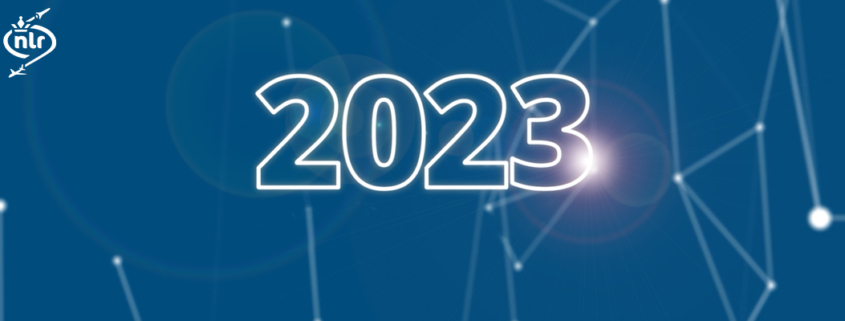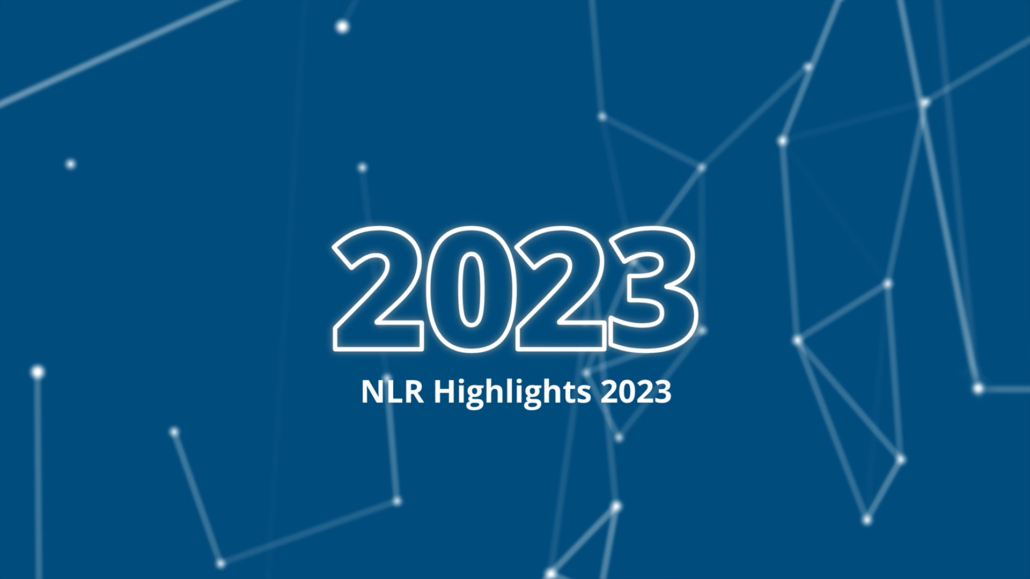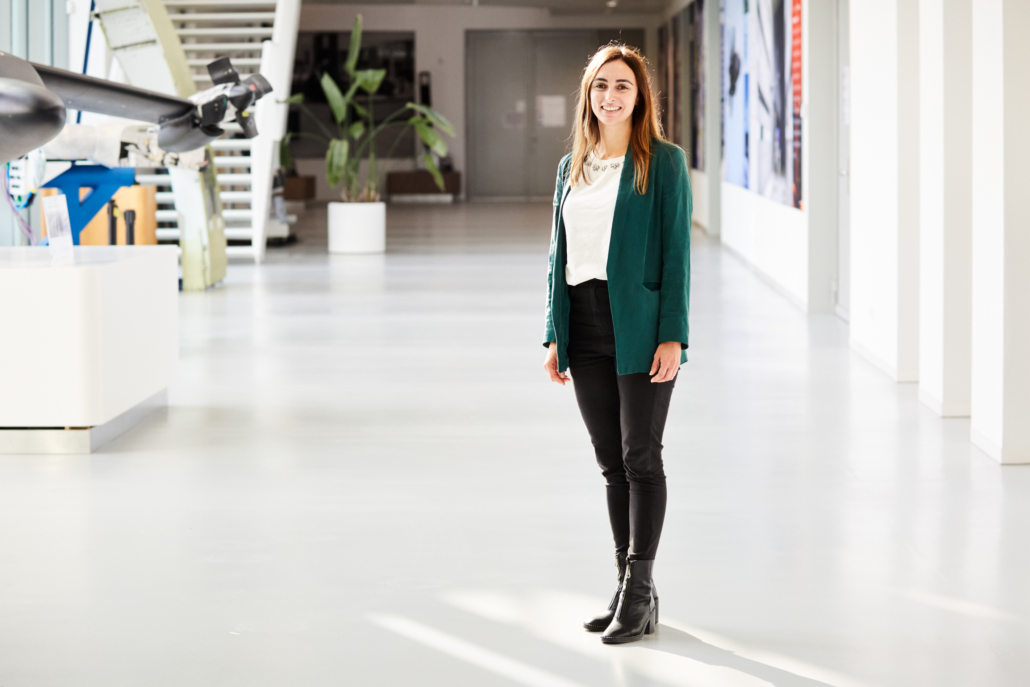Over the course of 2023, our efforts were devoted to many research projects. Some noteworthy ones are mentioned in this overview. Enjoy reading about our innovations and the people behind them, and don’t forget to watch the video for a first impression of a curated selection!
As we look back on the year 2023, we can assert that it has presented a multitude of challenges that have affected us all. As an applied research organisation, our leading knowledge and research facilities enable innovations, and allows us to bridge the gap between science, industry and government.
Over the course of 2023, our efforts were devoted to hundreds of research projects. Too many projects to condense, but we can look back with a sense of accomplishment on what we have achieved, particularly in relation to our steadfast commitments across our three strategic themes: Sustainable aviation, Competitive aerospace and Safe and secure society.
A curated selection of some of our noteworthy research projects is featured in the showreel below.
Enjoy!
Please find below a brief overview of the projects showcased in the video:
- Two nanosatellites were successfully launched at the beginning of 2023, as part of the MilSpace2 cooperation project. The satellites, each of which is not much larger than six one-litre cartons of milk, each measuring approximately 30x20x10 cm, are named after Norwegian physicist Kristian Olaf Birkeland and the Dutch astronomer Christiaan Huygens. This joint initiative involves collaboration between the Netherlands Ministry of Defence, the Norwegian Ministry of Defence, the Norwegian Defence Research Establishment (FFI), NLR, and the Netherlands Organisation for Applied Scientific Research (TNO). The launch, marking the Netherlands Ministry of Defence’s second foray into satellite deployment, aligns with the implementation of Defence Vision 2035, recognizing the critical role of space in modern military operations.
- Early summer, NLR successfully conducted a series of flight tests on behalf of both EASA and the FAA in Europe and on a NASA test field in the US.
- The soon-to-be concluded project STUNNING consists of a consortium of predominantly Dutch parties under the direction of GKN Fokker. STUNNING works within the Airbus-led Multi-Functional Fuselage Demonstrator (MFFD), to build the undercarriage part of an aircraft structure in composite, the world’s largest thermoplastic aircraft structure.
- Our electric two-seater, the Pipistrel Aircraft PH-NLX, flew from Maastricht Aachen Airport in the Netherlands to Aachen-Merzbrück in Germany. This cross-border flight contributed to intensify the exchange of knowledge about electric flight with batteries and (liquid) hydrogen between NLR and the German Aerospace Center (DLR).
- Flying electric as one of the puzzle pieces for a more sustainable aviation. EASIER, a project funded by the European Commission, allowed NLR to extend its thermal and EMC capabilities in electric flight and transfer existing knowledge on space cooling applications towards the aviation industry. The cooperation is continued through multiple other European projects such as Clean Aviation’s HECATE coordinated by Collins Aerospace.
- NLR and its collaborative partners in the European ClimOP project successfully concluded an extensive research endeavour centred around operational improvements aimed at addressing the complete spectrum of aviation’s climate impact, including non-CO2 effects.
- The ATTILA project is aimed at the design, manufacturing and testing of an advanced testbed for aeroelastic wind tunnel testing of tiltrotor aircraft. The challenge in designing rotor blades for wind tunnel testing lies in achieving strength and dynamic characteristics that closely resemble full-scale behavior, requiring precise stiffness and mass distribution along the entire span.
- Drones are a key enabler for innovative solutions to address the rapidly changing societal, economic, and security challenges. To enable Innovative Air Mobility (IAM) in urban settings, research and development in an experimental environment are crucial. In the new testing facility, NLR Drone DigiCity, startups, SMEs, businesses, and other organizations (knowledge, education, governments) can test their drones and related systems in a flexible simulated and conditioned urban environment.
This is just a glimpse of collaborations, projects and research we have been working on over the past year. Next to these, there were also several other initiatives worth mentioning:
- February 2023, the kick-off event for the National Growth Fund project Luchtvaart in Transitie took place at the Fokker Terminal in The Hague. With this national programme, the Dutch aviation sector has seized the opportunity to position itself in the forefront as a leading group that will shape and bring disruptive innovations to the market worldwide and aims to ensure that the Netherlands maintains its position on the international stage as an innovative and resilient aviation hub, allowing us to contribute even more to the economic prosperity of the country.
- The European Defence Fund (EDF) has announced funding for the REACTS consortium, which stands for Responsive European Architecture for Space. The consortium aims to establish a Resilient Network of Responsive Space System (RSS) Capabilities to enhance European defence. REACTS envisions a scalable network of resilient and integrable space capabilities, focusing on launching satellites and data delivery within a 72-hour window.
- During the Paris Air Show, the German ECOMAT and NLR combine their scientific and business expertise with regard to lightweight constructions, hydrogen developments, materials research and virtual product development in the aircraft manufacturing industry.
- Technological development has always been of great importance to the Dutch armed forces. The role of artificial intelligence is also increasing. For this reason NLR published a brochure to outline what NLR has to offer in the field of AI. See this link for more information (only in Dutch).
- What innovative solutions can help achieve a sustainable, clean and safe future for the Netherlands? And how can businesses continue to grow and innovate so that the Netherlands continues to prosper? You can find answers to these and other questions in the annual impact report (the TO2 magazine) of applied research organisations, referred to as TO2 institutes.
The people behind NLR’s ground-breaking innovations
In delving into the narrative of the individuals steering NLR’s ground-breaking innovations, we uncover a legacy of commitment, as our dedicated professionals have consistently pushed the boundaries of conventional thinking to craft market solutions that align with contemporary trends and effectively address global challenges. In the ‘NLR People’ series, we’ve provided glimpses into the lives of our experts throughout the year 2023, revealing their motivations and the behind-the-scenes dynamics.
Take Maria, for instance, an R&D engineer making significant strides in the aviation industry by focusing on additive manufacturing (AM) technologies. In her role, Maria explores the intricate combinations of microstructures and compositions of materials, emphasizing the importance of lightweight, cost-efficient, and eco-friendly aircraft. She compares her work to ‘high-tech’ patisserie, layering materials with precision. Beyond her technical achievements, she is dedicated to accelerating the adoption of AM in aviation by addressing certification challenges and promoting its safety, flexibility, and sustainability benefits.
Read Maria’s story and others here.
Together with our experts, we continue to carry out such projects and additional research, and persist in transforming knowledge into value, by providing practical solutions for the societal challenges that lie ahead. We firmly believe that by jointly embracing responsibility and strengthening our collaborations, we can ensure our readiness and navigate towards a resilient future.





 Royal NLR
Royal NLR